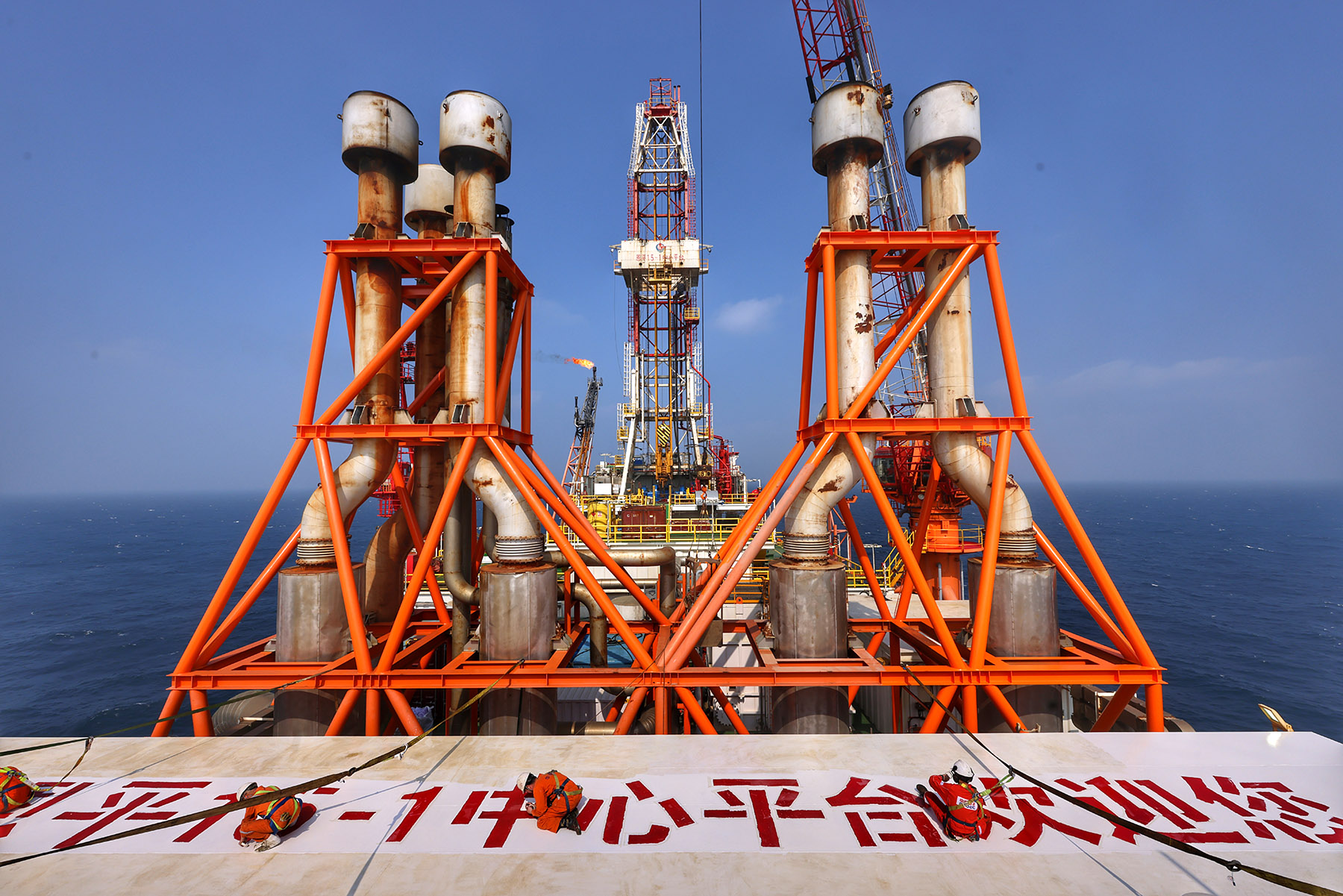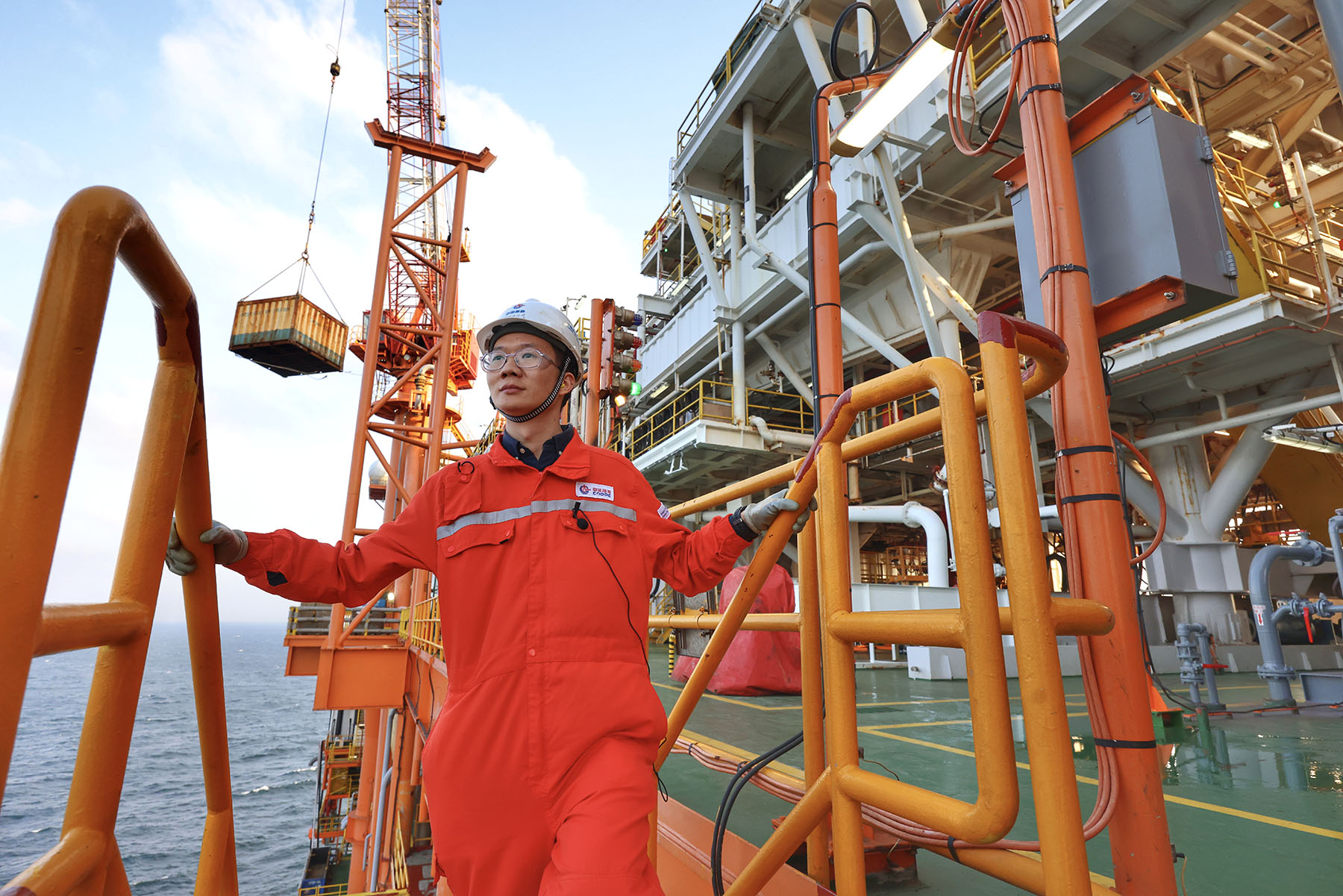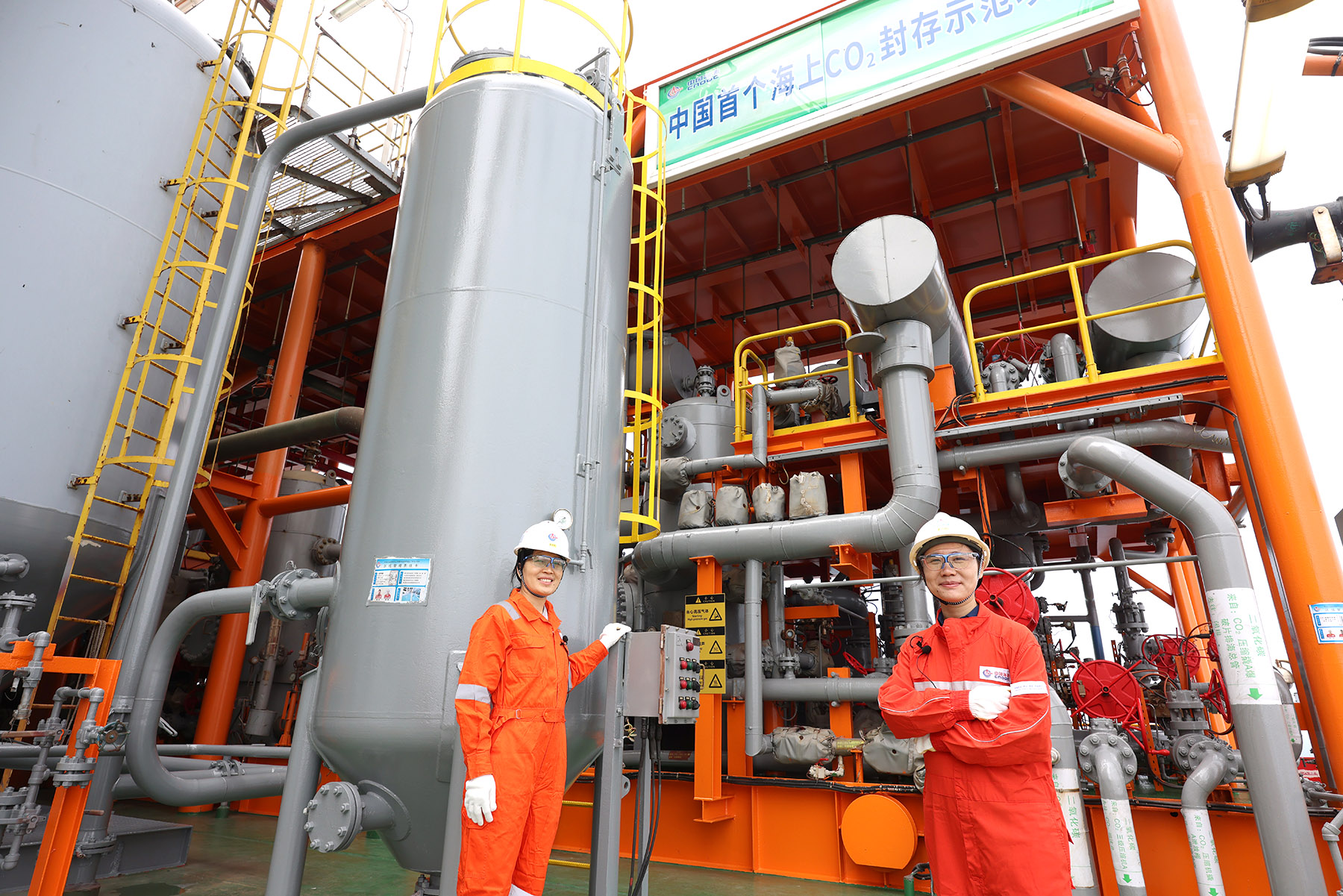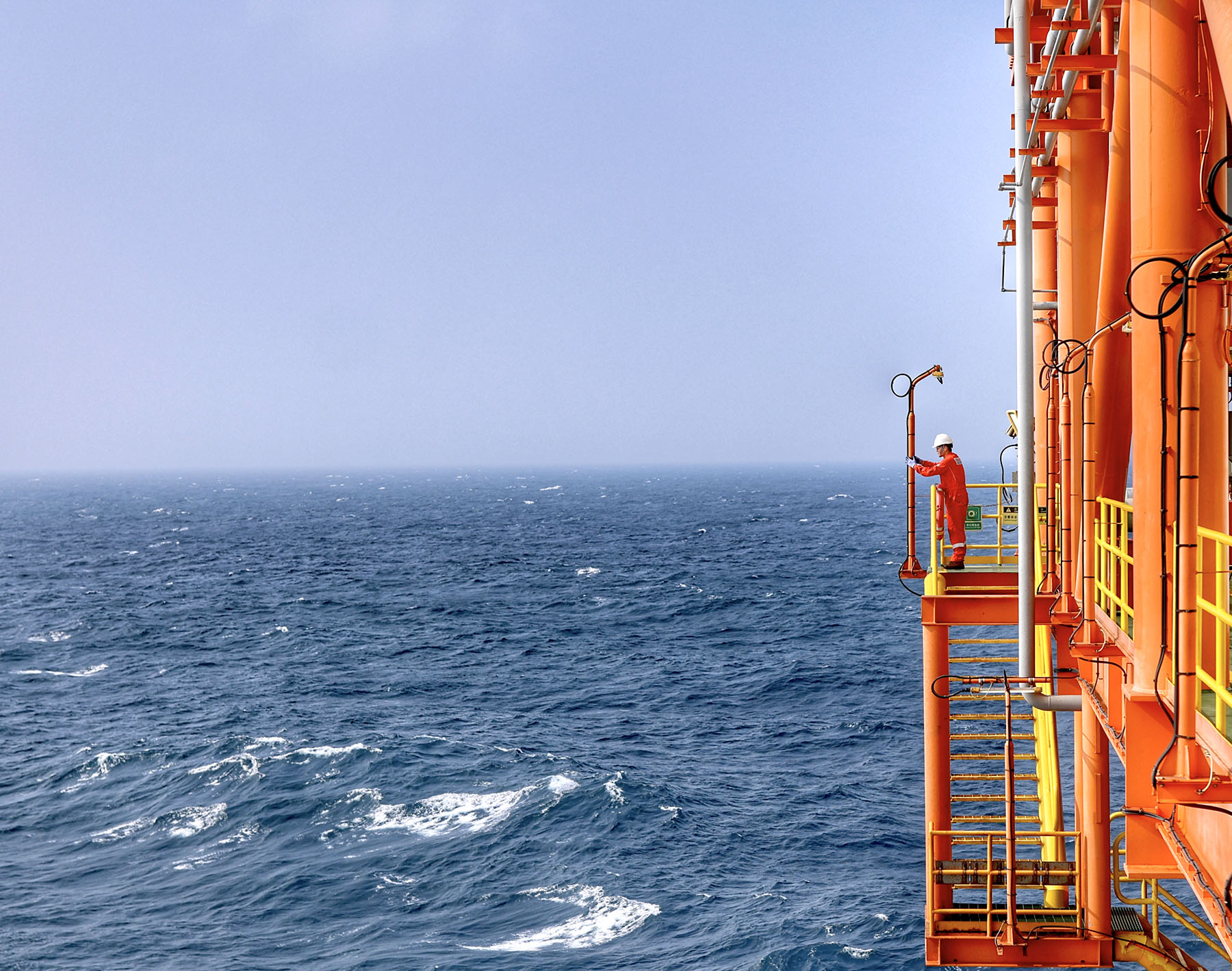Carbon storage project beneath South China Sea set to secure millions of tons of greenhouse gas

Editor's note: In this series, Greener Visions, China Daily delves into the research, development and implementation of cutting-edge carbon technologies in the Guangdong-Hong Kong-Macao Greater Bay Area, aiming to cut emissions and achieve carbon neutrality.
In a breakthrough to keep carbon dioxide permanently locked away, China has built a secure "prison" for the greenhouse gas deep beneath the South China Sea.
Located about 200 kilometers southwest of Shenzhen, Guangdong province, the Enping 15-1 oil platform hosts the nation's first megaton-sized offshore Carbon Capture, Utilization and Storage (CCUS) project. The platform, Asia's largest offshore oilfield, is operated by China National Offshore Oil Corporation (CNOOC).
READ MORE: China launches Asia's largest carbon capture project
The facility is designed to capture, secure and store 1.5 million metric tons of carbon dioxide annually — equivalent to planting 14 million trees or taking 1 million cars off the road for 30 years. Since its launch in June 2023, it has already injected and stored 180,000 tons of carbon dioxide beneath the seabed, marking a major step in China's fight against climate change.
The Enping 15-1 oil reservoir was selected for China's offshore CCUS demonstration project due to its unusually high CO2 content — a trait that once made extraction unviable. Traditionally, tapping such reserves would release carbon dioxide in the reservoir into the atmosphere, risking corrosion of platforms and pipelines while polluting the environment.
Recent advances in CCUS technology, however, have turned this challenge into an opportunity. The project now uses "CO2 flooding", a circular process where the capture system traps the carbon dioxide that emerges from extraction, and injects it for further oil extraction and permanent sequestration.
The method is a well-established CCUS technique used in oil drilling to enhance oil recovery. In this process, CO2 captured from industrial activities is transported via tanker trucks or pipelines and injected into oil reservoirs. The gas increases pressure, displacing scattered crude oil and boosting extraction rates, explained Xie Mingying, chief reservoir engineer at the Nanhai East Petroleum Research Institute at CNOOC's Shenzhen branch.
The Enping 15-1 oil platform announced it would begin CO2 flooding in May. Previously, captured CO2 had only been stored in a geological "dome" — a seabed structure 800 meters deep and located 3 kilometers from the platform.
Traditional oil recovery methods typically extract just 18 to 20 percent of a reservoir's crude oil.
However, CO2 flooding can increase recovery rates by 7 to 15 percent and extend the reservoir's life span by 15 to 20 years, according to Tang Yong, a professor at Southwest Petroleum University's Petroleum Engineering School.
While onshore CCUS projects have a longer operational history due to land-based logistic advantages, offshore CCUS initiatives remain relatively new, said Xie from the research institute.

One stone, two birds
The use of CO2 flooding will foster a win-win scenario by reducing emissions while enhancing oil production, said Mei Chuang, offshore installation manager of the Enping 15-1 platform. This marks a major leap from CO2 storage alone, to its active utilization.
Over the next 10 years, the project will inject over 1 million tons of CO2 into the Enping 15-1 oilfield, increasing crude oil production by 200,000 tons.
Li Wei, an offshore installation manager at the oil platform, said the associated gas in Enping's reservoir contains an exceptionally high CO2 concentration of about 95 percent.
Li is one of approximately 90 maintenance personnel working on the platform.
This gas undergoes a rigorous treatment process: separation and consolidation followed by dehydration and filtration through a pressurization system, before being injected into a dome structure within the deep saline aquifer.
While some sequestered CO2 may resurface during oil recovery, it's recaptured and reused, creating a closed-loop system that boosts production while slashing emissions.
Li said that other gases from the reservoir are utilized for on-site power generation, enabling the platform to achieve full energy self-sufficiency. "This approach not only ensures operational independence but also significantly reduces our emissions," he said.
Homegrown technologies
The Enping 15-1 CCUS project features seven key technologies developed domestically that enable China to independently execute such offshore operations.
Sun Xiaona, senior reservoir engineer at the Nanhai East Petroleum Research Institute of CNOOC's Shenzhen branch, said the project provides a critical technological foundation for future large-scale offshore CCUS initiatives.
These breakthroughs are pivotal for CNOOC's larger endeavor — a 10-megaton CCUS project in Daya Bay, Huizhou, Guangdong. This ambitious project is being developed in collaboration with Guangdong authorities, ExxonMobil, and Shell.
The partners signed a Memorandum of Understanding in June 2022, outlining plans to construct China's first offshore CCUS cluster, with an eventual annual sequestration capacity of 10 million tons.
The first phase of the project is designed to handle a capacity to capture up to 1 million tons of CO2 a year. The second project phase will see the capacity increased to 2 million tons annually.
The project is located in the Daya Bay Petrochemical Industrial Zone — China's top petrochemical hub for the past five years. The zone has a high concentration of refineries and chemical plants with high carbon dioxide emissions and strong decarbonization demands, making it an ideal choice for this CCUS hub.
Under the plan, industrial CO2 will be captured onshore, transported offshore, and permanently stored beneath the seabed.
China National Offshore Oil Corporation will transport and sequester captured CO2 offshore, likely in the eastern South China Sea, Xie said.
"As a State-owned enterprise, CNOOC must help the Greater Bay Area address climate change while pursuing sustainable development," she said.
However, she acknowledged there are significant challenges for the project to overcome. Offshore sequestration, while safer than land storage, requires massive investment due to the South China Sea's 100-meter average depth. Deeper waters further increase technical and financial hurdles.
"CO2 storage itself isn't profitable," Xie noted. "The economic incentive comes from finding productive uses for captured carbon."

Going big
In its quest for net-zero emissions, China is betting big on the nascent technology.
As of November 2022, the number of CCUS demonstration projects in China in operation, under construction or being planned, was more than 100, according to CCUS Progress in China — a status report released in 2023 by the Global CCS Institute, Tsinghua University, and the Administrative Center for China's Agenda 21.
Nearly half the projects are operational, the report said, with an annual CO2 capture capacity exceeding 4 megatons and injection surpassing 2 megatons — marking increases of roughly 33 percent and 65 percent respectively, since 2021.
In April 2024, China unveiled its first batch of green, low-carbon technology demonstration projects eligible for government grants. Of 47 selected projects, six were CCUS technology related.
As the number of projects grows, they have spread across diverse industries, spanning traditional sectors like oil and gas, chemicals and electricity, to industries including cement, and iron and steel. These are generally considered sectors where it is hard to cut emissions.
In June 2023, the Taizhou Power Plant in Jiangsu province commissioned Asia's largest coal-power CCUS facility, with an annual capacity of 500,000 tons of carbon dioxide — a milestone for the region's energy transition.
Beyond enhanced oil recovery, China is exploring innovative CO2 applications, including microalgae cultivation and high-value product manufacturing.
In December 2022, Zhejiang University and Guangdong Energy Group jointly established the first demonstration project using flue gas for microalgae cultivation and CO2 sequestration at Guangdong Yudean Zhanjiang Biomass Power Generation Co.
In 2024, the Global CCS Institute's Global Status report for the first time devoted a separate section to the development of CCUS in China, as the technology gained wider international traction.

Growing acceptance
As of July 2024, the number of global carbon capture and storage projects in development had surged to 628, marking a 60 percent year-on-year jump, the CCS 2024 report showed.
Another 50 CCS facilities were in operation, with 44 under construction.
The International Energy Agency reports a surge in CCUS development, with 38.4 megatons a year capacity under construction, and 346.8 megatons in planned projects to be achieved by 2030.
By 2030, this growth could help CCUS deliver 8 percent of emissions reductions needed to meet net-zero goals, according to the IEA's 2023 analysis. The agency emphasizes the current decade is critical for scaling investments to meet climate targets.
Recognizing CCUS' decarbonization potential, many countries are taking action to incorporate it in their push to carbon neutrality.
The United Kingdom and Japan have implemented policies to accelerate CCUS deployment, while also developing related regulatory frameworks and technical standards.
In Asia, countries constrained by land such as Singapore, South Korea, and Japan, are making cross-border agreements to export CO2 for storage in nations with abundant geological capacity, including Australia, Malaysia, and Indonesia.
Xie emphasized the need for expanded policy support to drive adoption of CCUS. Citing Singapore's carbon tax as an effective model, she said such measures create financial incentives for emission reductions.
Direct subsidies for CCUS projects, enterprise carbon allowances, and the expansion of carbon trading mechanisms to further stimulate private sector engagement could be introduced, she said.
Sun, from the Panyu Development Office, said: "When key conditions align — including suitable large-scale storage sites, higher carbon credit prices, and robust policy support — the CCUS industry will reach its tipping point."
ALSO READ: Drilling platform captures, stores carbon
China's maritime territories have immense CO2 storage capacity, with a total of 2.58 trillion tons of offshore storage potential. The Pearl River Delta is able to store 300 billion tons, according to a report released in January 2023 by the China Geological Survey at the Ministry of Natural Resources.
"The Greater Bay Area presents a unique opportunity," Sun said. "Its vibrant industries demand emission solutions that align perfectly with these massive undersea storage resources."
However, she highlighted key challenges for the Daya Bay CCUS project.
The primary challenge involves identifying and consolidating dispersed onshore carbon sources. A second major difficulty lies in ensuring the safe, efficient transportation of these substantial volumes of gas to precise undersea storage locations. Perhaps most critically, the storage duration presents unique challenges — requiring containment security for potentially thousands of years.
Sun emphasized that unlike typical industrial projects spanning decades, CCUS demands consideration of long-term consequences, including assessing whether stored gases might eventually re-enter marine ecosystems centuries later.
stushadow@chinadailyhk.com


